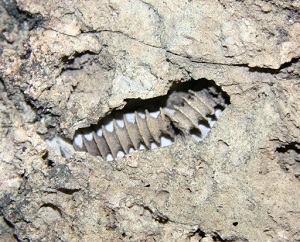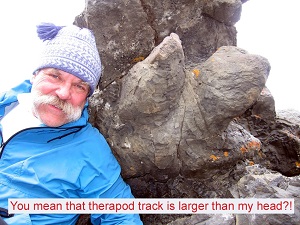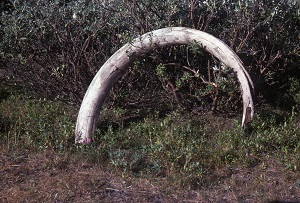Many different kinds of animals have lived on Alaska's lands and have swum in its waters over the ages. Alaska's climate fluctuated from warm to cold and water ecosystems uplifted into land. Living things perished as their environment changed, but their forms, remains, and traces of their existence were sometimes preserved in the sediments and rocks as fossils.

Crinoid columnal, still articulated. Age is Permian or Pennsylvanian, about 320 to 250 million years ago. Photo credit: David Szumigala, DGGS.
Some of the earliest fossils known in Alaska are from the Paleozoic Era about 550 to 250 million years ago. Most of Alaska was under water during this time. Consequently, recovered fossils include algal mats (stromatolites) and marine critters such as trilobites, echinoderms, and brachiopods.

Scientists and students first discovered dinosaur tracks in Denali National Park in 2005. Photo credit: National Park Service, July 16, 2010.
About 250 to 70 million years ago, Alaska's land started to take shape due to mountain building from drifting tectonic plates and newly created volcanic ground, although portions of the state were still forming under water. Alaska's fossil record contains a large variety of Mesozoic animals, from ancient marine reptiles and other sea dwellers to early mammals and dinosaurs. Dinosaurs and/or their footprints have been discovered from southeast Alaska to the North Slope and species include pachyrhinosaurus, hadrosaurus, and other plant eaters, as well as meat-eating theropods like Nanuqsaurus (meaning "polar bear lizard").

Mastodon tusk discovered on the North Slope. Photo credit: Gil Mull, DGGS, taken July 1, 1977.
During the Cenozoic Era about 70 million years ago to present, Alaska's land mass completed the transition into its current configuration, now with several mountain ranges and broad, flat basins. Alaska's climate still fluctuated, but generally became colder and drier over time. Although dinosaurs went extinct at the end of the Mesozoic, small mammals and marine animals continued to evolve and grow larger. During the Pleistocene, which began 2.5 million years ago, much of Earth's water was locked up in giant ice sheets and the Bering Land Bridge was exposed, linking Alaska to Russia. Pleistocene animals like the Woolly Mammoth, Alaska's state fossil, and the Giant Beaver roamed the grassy plains and boreal forests. Early humans are thought to have crossed over to North America from Asia about 15,000 years ago.
Fossil finds such as bones, burrows, and plant casts and artifacts, left from early human civilizations, are important to researchers looking for clues about the Earth's history and our past. Because any fossil or artifact that is damaged or removed from its location loses critical scientific data, the legal collection of fossils and artifacts is limited by the type of find and the location of the find. Federal, state, and private landowners each have different rules for allowed activities. Most landowners do not allow the collection of vertebrate fossils or artifacts. Vertebrate animals have a backbone, such as humans, other mammals, dinosaurs, birds, and fish. Know the landowner's rules and obtain any required permits before hunting for fossils. If you discover a protected fossil or artifact, don't disturb it. Leave it in place, record its location, take pictures, and inform the landowner. You could spark the next scientific find of the century, but only if you leave the fossil safely in place!